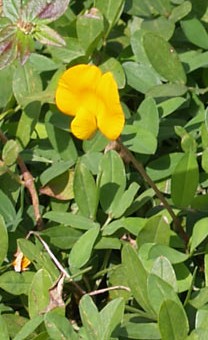 Peanuts are annuals and are hybrids developed and domesticated in Argentina. They are a member of the bean/pea family (Leguminosae/Fabaceaea) and like other plants in the family contain symbiotic bacteria in their root nodules that are able to fix nitrogen from the air into the soil. The leaves are pinnately compound with four leaflets each being up to 2 ¾” long and up to 1” wide. The flowers are about ½” across, are yellow-orange with reddish veining and have the typical structure of bean flowers with a keel and banner. Although the bloom time is long, each flower lasts only one day and if fertilized develops a structure called a peg that pushes the ovary under the soil where it develops into a fruit that is technically a legume (commonly called a pod) rather than a nut. This unusual underground fruit development makes peanut a great choice for planting with children. The generic name, Arachis, comes from the Greek word for plant; the specific epithet, hypogaea, means underground.
Peanuts are annuals and are hybrids developed and domesticated in Argentina. They are a member of the bean/pea family (Leguminosae/Fabaceaea) and like other plants in the family contain symbiotic bacteria in their root nodules that are able to fix nitrogen from the air into the soil. The leaves are pinnately compound with four leaflets each being up to 2 ¾” long and up to 1” wide. The flowers are about ½” across, are yellow-orange with reddish veining and have the typical structure of bean flowers with a keel and banner. Although the bloom time is long, each flower lasts only one day and if fertilized develops a structure called a peg that pushes the ovary under the soil where it develops into a fruit that is technically a legume (commonly called a pod) rather than a nut. This unusual underground fruit development makes peanut a great choice for planting with children. The generic name, Arachis, comes from the Greek word for plant; the specific epithet, hypogaea, means underground.
Type: Annual
Bloom: Orange yellow with reddish veining in summer
Size: Clump 12” around
Light: Full sun
Soil: Loose, low in organic matter, moist, well drained; warm
Hardiness: Not relevant
Care: Low maintenance
Pests and Diseases: None of significance
Propagation: Seed planted in the garden, not a pot.